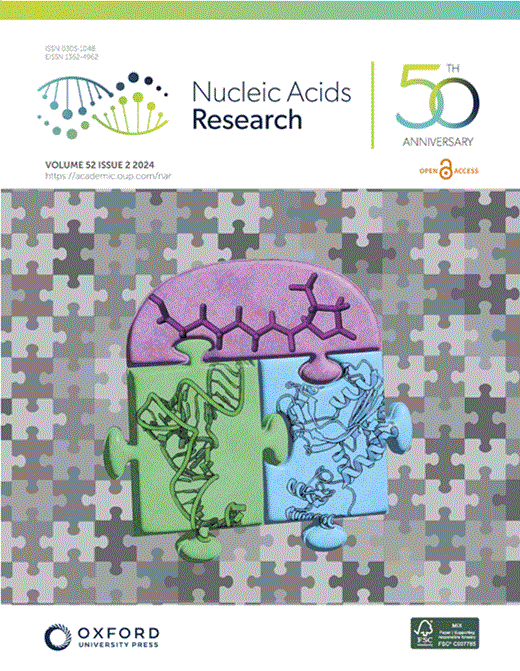Widespread 3′ UTR splicing regulates expression of oncogene transcripts through multiple mechanisms
IF 16.6
2区 生物学
Q1 BIOCHEMISTRY & MOLECULAR BIOLOGY
引用次数: 0
Abstract
Splicing in 3′ untranslated regions (3′ UTRs) is generally expected to elicit degradation via nonsense-mediated decay (NMD) due to the presence of an exon junction complex (EJC) downstream of the stop codon. However, 3′ UTR intron (3UI)-containing transcripts are widespread and highly expressed in both normal tissues and cancers. We present a transcriptome assembly built from 7897 solid tumour and normal samples from The Cancer Genome Atlas. We identify thousands of 3UI-containing transcripts, many expressed across multiple cancer types. Expression of NMD component UPF1 negatively correlates with 3UI-splicing in normal, but not colon cancer, samples. 3UIs found exclusively within 3′ UTRs (bona-fide 3UIs) are not predominantly NMD-sensitizing, unlike introns found in 3′ UTRs due to the presence of an early premature termination codon (PTC). We identify 3UI-splicing that rescues the transcript from NMD. Bona-fide 3UI-transcripts are over-spliced in cancer samples. In colon cancer, differentially-spliced 3UI transcripts are enriched in the Wnt signalling pathway, with CTNNB1 showing the greatest increase in splicing. Manipulating Wnt signalling can further regulate 3UI-splicing of Wnt components. Our results indicate that 3′ UTR splicing is not a rare occurrence and 3UI-splicing can regulate transcript expression in multiple ways, some of which are likely to be EJC-independent.广泛存在的3 ' UTR剪接通过多种机制调节癌基因转录物的表达
由于终止密码子下游存在外显子连接复合体(EJC),通常预计3 ‘非翻译区(3 ’ utr)的剪接会通过无义介导的衰变(NMD)引起降解。然而,含有3 ' UTR内含子(3UI)的转录本在正常组织和癌症中广泛存在并高度表达。我们提出了从癌症基因组图谱中的7897个实体肿瘤和正常样本构建的转录组组装。我们鉴定了数千个含有3ui的转录本,其中许多在多种癌症类型中表达。在正常样本中,NMD成分UPF1的表达与3ui剪接呈负相关,而在结肠癌样本中则没有。由于存在早期终止密码子(PTC),仅在3 ' utr内发现的3ui(真正的3ui)不像在3 ' utr中发现的内含子那样主要对nmd敏感。我们鉴定出3ui剪接可以将转录本从NMD中拯救出来。真正的3ui转录本在癌症样本中被过度拼接。在结肠癌中,差异剪接的3UI转录本在Wnt信号通路中富集,其中CTNNB1的剪接增加最多。操纵Wnt信号可以进一步调控Wnt组分的3ui拼接。我们的研究结果表明,3 ' UTR剪接并不罕见,3ui剪接可以通过多种方式调节转录物的表达,其中一些可能与ejc无关。
本文章由计算机程序翻译,如有差异,请以英文原文为准。
求助全文
约1分钟内获得全文
求助全文
来源期刊

Nucleic Acids Research
生物-生化与分子生物学
CiteScore
27.10
自引率
4.70%
发文量
1057
审稿时长
2 months
期刊介绍:
Nucleic Acids Research (NAR) is a scientific journal that publishes research on various aspects of nucleic acids and proteins involved in nucleic acid metabolism and interactions. It covers areas such as chemistry and synthetic biology, computational biology, gene regulation, chromatin and epigenetics, genome integrity, repair and replication, genomics, molecular biology, nucleic acid enzymes, RNA, and structural biology. The journal also includes a Survey and Summary section for brief reviews. Additionally, each year, the first issue is dedicated to biological databases, and an issue in July focuses on web-based software resources for the biological community. Nucleic Acids Research is indexed by several services including Abstracts on Hygiene and Communicable Diseases, Animal Breeding Abstracts, Agricultural Engineering Abstracts, Agbiotech News and Information, BIOSIS Previews, CAB Abstracts, and EMBASE.
 求助内容:
求助内容: 应助结果提醒方式:
应助结果提醒方式:


